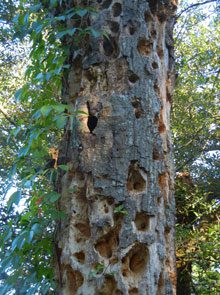 Here at the farm, camellias – those magnificent queens of the southern garden – have been a part of the landscape for a very long time. While none of the shrubs/trees date all the way back to the 1840-ish origin of the farmhouse, these big old plants are very prominent under the oaks and hickories, blooming faithfully year after year from late September until March or April.
Here at the farm, camellias – those magnificent queens of the southern garden – have been a part of the landscape for a very long time. While none of the shrubs/trees date all the way back to the 1840-ish origin of the farmhouse, these big old plants are very prominent under the oaks and hickories, blooming faithfully year after year from late September until March or April.
The oldest, a pair of very handsome Camellia japonica bushes, produce each winter masses of handsome classic double cherry-red blooms, each bush growing and blooming slightly differently to its companion. One grows with an upright habit; its flowers are usually slightly paler than those on its nearby sister. The sister bush seems to want to make a weeping habit, its branches bending downward a bit as they reach out – especially when the branches are laden with dozens of perfect formal double red-pink flowers.
When my parents bought the farmhouse and its surrounding buildings in the 1970s – nearly a half century ago! – these two camellias had been growing for many decades among three old oak trees, with whom they had competed for moisture and nutrients from the soil. Growth is slow under such circumstances, but the camellias had reached some seven feet in height and eight feet in width. They are now nine feet tall and ten feet across; it’s taken them fifty years to reach out two more feet.
Younger, but much larger, are the two Camellia sasanqua trees, which had been planted in the 1940s. Both are the simple, single-flowered, fast-growing sasanquas popular in southern gardens long before modern hybridization introduced such variety of form and color. They bloom months earlier than the C. japonicas, beginning to flower as the fall weather approaches, and seem much more accepting of full sun.
The huge sasanqua in the side yard – it’s nearly fifteen feet tall – is covered for weeks each October with the palest pink single blooms, each flower lasting only a couple of days, but replaced with another as soon as it falls. Its vitality I long attributed to its location shading the old hen house (now long gone), but it is more likely simply genetics.
There’s an equally robust Camellia sasanqua in the back yard. This one blooms with single white flowers at about the same time as the pink one. Some thirty five years ago, my father decided it had gotten too large for its place and completely cut it back to its very substantial stump, about two feet above the ground. This  “bush” is now twelve feet tall and fifteen feet across!
“bush” is now twelve feet tall and fifteen feet across!
Beneath the pecan trees and redbuds on the west side of the house, my father’s beloved camellia garden began to take shape in the 1980s. He began buying camellias he liked and locating them in partial shade, offering them plenty of space to grow, some irrigation, and a location where their months of bloom each winter could be enjoyed from the house. Under such conditions, even slow growing camellias can attain size and mass surprisingly quickly. One, a Professor Sargent, is twice my height with a spread of some seven feet, and quite densely branched. Others are not quite so big, but handsome plants indeed.
Finally, along the eastern side of the farmhouse, my father decided to plant a foundation row of camellias – fast growing hybrid sasanquas – to make a low green wall at the base of the house.
Here’s where my problem lies. The plants, small when acquired, were planted some four feet from the house. They are all, regrettably, fast-growing, although some grow faster than others. Despite the spectacular blooms they put on every fall and early winter, they have now reached the windows on the second floor – no longer just a green foundation planting, but a wall of green covering the east side of the house.
It is long past time for me to get out the loppers and do something – drastic!
One possibility is to follow my father’s practice years ago and chop everything down to a low stump. Most will likely recover and start blooming in a couple of years. Another is to be more judicious in my pruning, maintaining a decent looking shrub over the seasons it will take for me to repeatedly cut portions back to a handleable size.
 But what are the rules? How do I prune in a way that won’t damage or even kill the camellia?
But what are the rules? How do I prune in a way that won’t damage or even kill the camellia?
The primary recommendation given by the experts is to limit pruning to the time immediately after blooming. The reasoning for this is to prune before the next year’s blooms are set on the exiting branches; that is, it is to try to assure that you’ll get blooms on the plants next fall and winter.
Sasanquas have usually finished flowering by February. That might seem like a decent time to prune. However, I am far less concerned about losing one season of bloom than I am about losing new growth to a freeze. It’s hard to remember that pruning is only partially about removing growth; even more, pruning is a major impetus for the cut plant to send out new growth. If I cut in February (or in October, November, December, January . . . maybe even March!) new growth will immediately start where I have cut. That tender new growth is extremely vulnerable to any freezes; it will likely be killed back.
Far better to choose a more reliable time for pruning, when there will be sufficient time for new growth to harden off before facing a freeze. March is probably the earliest for safe pruning here at the farm. That’s probably still early enough for the plant to form its flower buds for the fall, but that’s not my main worry. I can still prune through the summer, but once fall begins, I need to worry that new growth may be vulnerable to the coming cold weather. I just don’t worry about missing a year of flowering if I’m reasonably assured of a healthy plant.
Here’s the pruning I will do – it will require a bit of assessing each plant for it to work. The idea is to remove no more than about a third of the mass of growth each season, leaving most of the bush alone to keep growing and flowering.
Because these plants have grown so enormous, that presents a challenge. I will remove the tallest trunks/stems, cutting them out as near to the base or trunk as I can. I imagine this will require only removing one or two of these main tall branches to make up a third of the bush’s growth, but some, with smaller branches will require cutting out five or ten branches to eliminate one third of the bush. These, too, will be cut as close to the base of the branch as possible.
During the year, I will try to keep any new growth from becoming too large, and next year, when warm weather comes after the blooming season, I will identify and remove another third of the old growth in the same way. And finally, by the third season, after pruning back that final third of old branches, I will be left with a completely new bush, much more contained in size and ready to keep pruned more regularly than I’ve been doing.
On the other hand, the giant sasanquas out in the yard may just get the chop-off approach. One has only so much energy and discipline to spare; and, after all, it worked for my father!







